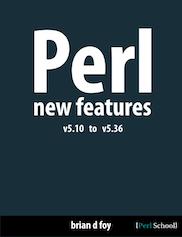You can specify literal hexadecimal floating-point numbers in v5.22, just as you can in C99, Java, Ruby, and other languages do. Perl, which uses doubles to store floating-point numbers, can represent a limited set of values. Up to now, you’ve had to specify those floating point numbers in decimal, hoping that a double could exactly represent that number. That hope, sometimes unfounded, is the basis for the common newbie question about floating point errors. Continue reading “Perl v5.22 adds hexadecimal floating point literals”
Category: book
Use Perl 5.22’s <<>> operator for safe command-line handling
We’ve had the three argument open since Perl 5.6. This allows you to separate the way you want to interact with the file from the filename.
Old Perl requires you to include the mode and filename together, giving Perl the opportunity to interpret what you mean: Continue reading “Use Perl 5.22’s <<>> operator for safe command-line handling”
Use v5.20 subroutine signatures
 This is a chapter in Perl New Features, a book from Perl School that you can buy on LeanPub or Amazon. Your support helps me to produce more content.
This is a chapter in Perl New Features, a book from Perl School that you can buy on LeanPub or Amazon. Your support helps me to produce more content.
This feature was promoted to a stable version in v5.36.
Subroutine signatures, in a rudimentary form, have shown up in Perl v5.20 as an experimental feature. After a few of years of debate and a couple of competing implementations, we have something we can use. And, because it was such a contentious subject, it got the attention a new feature deserves. They don’t have all the features we want (notably type and value constraints), but Perl is in a good position to add those later. Continue reading “Use v5.20 subroutine signatures”
Use the :prototype attribute
Perl 5.20 introduced experimental subroutine signatures. Now two features vie for the parentheses that come after the name in a subroutine definition. To get around that, v5.20 introduced the :prototype attribute.
There’s not much to this. Here’s a prototype for a subroutine that takes two arguments:
sub add ($$) { ... }
Change that to the attribute form:
use v5.20;
sub add :prototype($$) { ... }
But, you probably don’t need prototypes in the first place. You might consider simply getting rid of them altogether.
Subroutine signatures are experimental and have to go through at least two maintenance releases before they can graduate out of an experimental feature, so be ready for that. I expect that most people will have problems with module code they don’t control, so you might be at the mercy of the module maintainers.
Perl v5.18 adds character class set operations
Perl v5.18 added experimental character code set operations, a requirement for full Unicode support according to Unicode Technical Standard #18, which specifies what a compliant language must support and divides those into three levels.
The perlunicode documentation lists each requirement and its status in Perl. Besides some regular expression anchors handling all forms of line boundaries (which might break older programs), set subtraction and intersection in character classes was the last feature Perl needed to be Level 1 compliant. Continue reading “Perl v5.18 adds character class set operations”
Don’t use named lexical subroutines
Lexical subroutines are a stable feature starting with v5.26
Perl v5.18 allows you to define named subroutines that exist only in the current lexical scope. These act (almost) just like the regular named subroutines that you already know about from Learning Perl, but also like the lexical variables that have limited effect. The problem is that the feature is almost irredeemably broken, which you’ll see at the end of this Item. Continue reading “Don’t use named lexical subroutines”
Enforce ASCII semantics when you only want ASCII
When Perl made regexes more Unicode aware, starting in v5.6, some of the character class definitions and match modifiers changed. What you expected to match \d, \s, or \w are more expanvise now (Know your character classes under different semantics). Most of us probably didn’t notice because the range of our inputs is limited. Continue reading “Enforce ASCII semantics when you only want ASCII”
Use a computed label with loop controllers
Not sure which loop you want to break out of? Perl v5.18 makes that easy with computed labels. The value you give next, last, and redo no longer has to be a literal. You could already do this with goto, but now you can give the loop controllers an expression. Continue reading “Use a computed label with loop controllers”
Perl v5.20 fixes taint problems with locale
Perl v5.20 fixes taint checking in regular expressions that might use the locale in its pattern, even if that part of the pattern isn’t a successful part of the match. The perlsec documentation has noted that taint-checking did that, but until v5.20, it didn’t.
The only approved way to untaint a variable is through a successful pattern match with captures: Continue reading “Perl v5.20 fixes taint problems with locale”
Use postfix dereferencing
[Update: This feature became stable in Perl v5.24]
Perl v5.20 offers an experimental form of dereferencing. Instead of the complicated way I’ll explain in the moment, the new postfix turns a reference into it’s contents. Since this is a new feature, you need to pull it in with the feature pragma (although this feature in undocumented in the pragma docs) (Item 2. Enable new Perl features when you need them. and turn off the experimental warnings: Continue reading “Use postfix dereferencing”